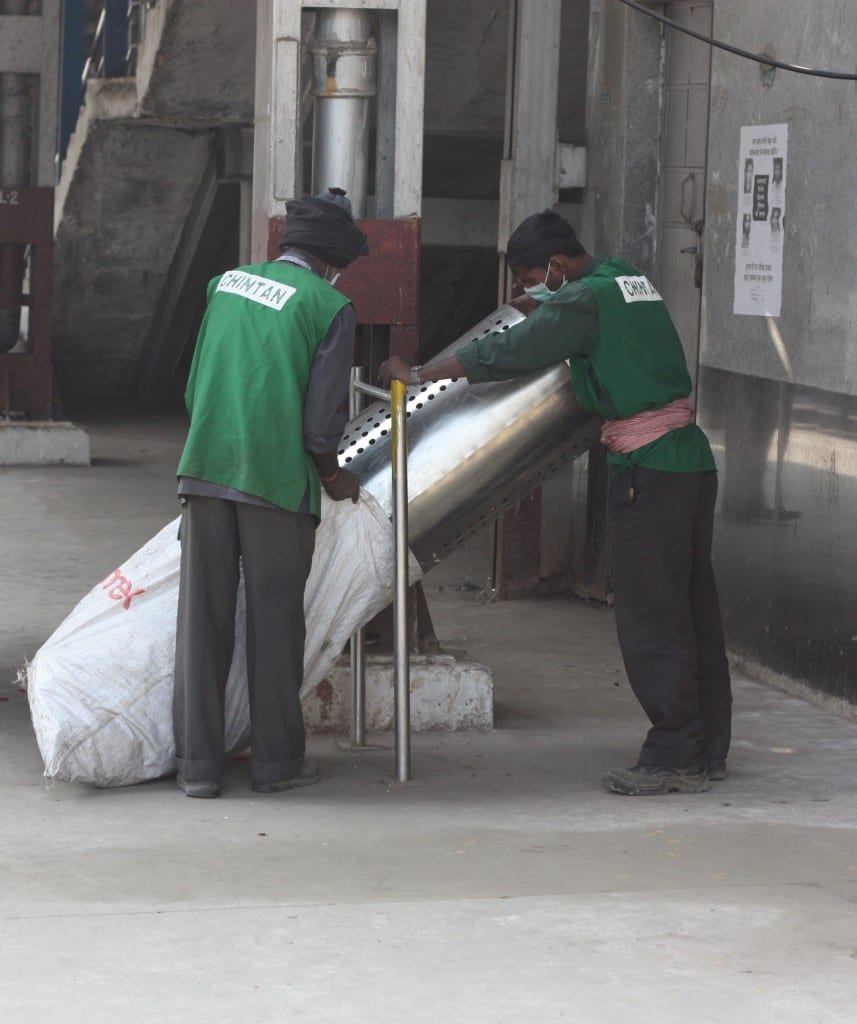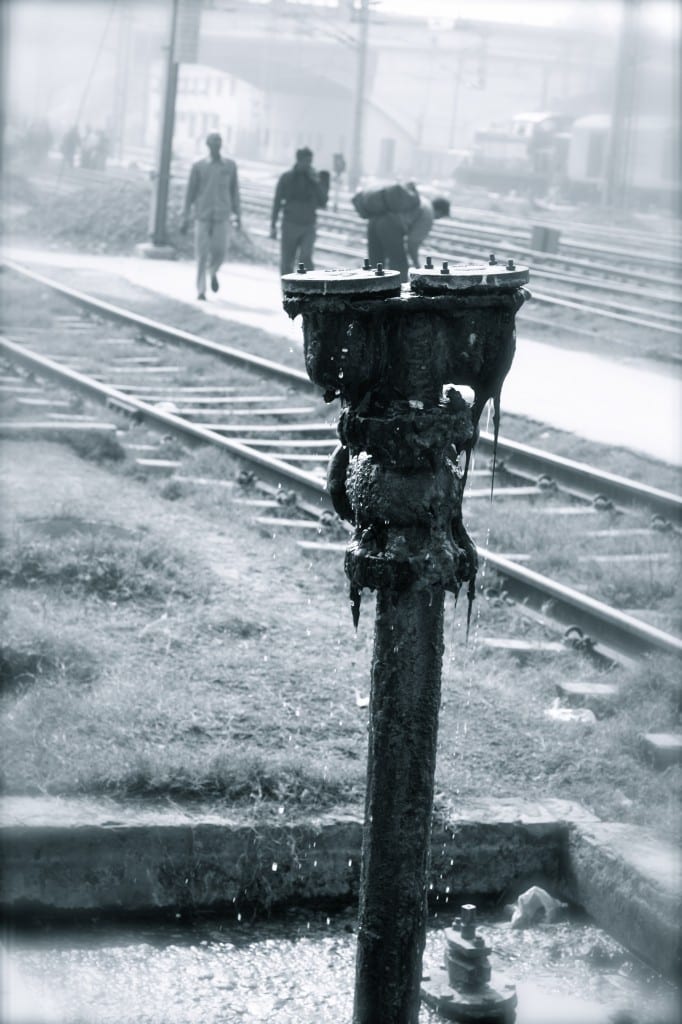I had arrived at New Delhi Railway station a bit too early and was now waiting for my colleague Brij to arrive and introduce me to Chintan’s “Low Carbon Future” programme. Not really having the time to wander off and to have a stroll around, I decided to just wait outside the metro station from which I had just come. So I began to observe the constant and busy flow of people who were quickly rushing from the metro to the railway station, and of course the other way around.
If you’ve ever been to Delhi then you know that this is a very hectic city. Especially the use of public transport can be very tiresome. As I have already mentioned in a previous post, the metro has made travelling longer distances within the city more convenient and – what is probably most important for the majority of commuters – it makes travelling around the city very cheap. Evidently, when I say that the metro is “convenient”, I only mean that it gets you rather quickly form one part of the city to the other. I don’t want to imply that taking the metro is generally an activity that I look forward to. People in Delhi are in usually very friendly and always willing to help. However, whenever they set foot into one of the metro stations, they mutate into some sort of Darwinian homo metropolaris (sorry!!). It seems that only the strongest travellers can reach their destinations. At least that’s the impression you get whenever someone pushes you with both hands through the opening doors of the metro, not allowing any passengers get out of the cabin.
Another instance when you might be reminded of the “survival of the strongest” shibboleth is when you are just foolish enough not to use the full extent of the earth’s gravitational force whenever you want to sit down. Let me explain: In the highly unlikely event of the person sitting next to where you stand deciding to get up, and as you’re in the process of sitting down onto that person’s now empty seat, it can happen that someone will “steal” the seat from underneath your bottom. As unbelievable as it sounds, some people indeed manage to do this by using the speed acquired from sprinting the three to five meters that they stood away from you and throwing themselves into that gap (by now you’re in a semi-crouched position) between your bum and the (technically still empty) seat. Seat stealing is an art that needs to be learnt, but for which some people have developed a very refined technique.
Whenever the metro is not overcrowded, and like me you’re a relatively tall westerner who hasn’t had a proper hair cut in more than half a year (ok, I must admit that this is my own fault) you’ll get a lot of strange looks and some people will just stare at you for minutes. Strangely enough they do not seem to stop whenever you start staring back. You’ll have to learn just need to live with it.
Anyway, enough of this excursus on the use of the metro in Delhi! I just had another metro journey behind me and I hope you now understand that when I had arrived at the railway station, I did not mind a break. I felt that it was now my turn to do some people watching.
It is bizarre how a city (or at least your experience of it) can change all of a sudden whenever you decide to leave its hectic flow and moving around and become static for some time. Standing there, I realised that amongst the rushing commuters, there was also a slower, more relaxed and tranquil world, which co-exists in the same space. I observed two newspaper vendors who were sitting on the floor amongst the hundreds of the people rushing past every minute. Quite unimpressed by all the frenzy going on around them, they had a chat with one another and a bit later they bribed a station official in order to be allowed to remain seated on the pavement. A couple of yards away was a tobacco vendor standing at a small mobile stand. Many passers-by interrupted their journey here and stopped to chew some tobacco or buy a cigarette. Obviously many of these people were regulars who also wanted to have a chat and a small break before getting on with their busy days.
Finally my colleague Brij arrived and I was taken into the railway station. Brij did however not take me in the “normal” way past the x-ray machines where the police check you for bombs and guns. Instead I was taken to the part of the station where the incoming and outgoing merchandise is handled. If you know where to go, you can just enter this area of the station and nobody will care (so much about the effectiveness of the security controls at the official station entrance). Entering the station area this way actually feels a bit like an adventure. A whole new world opened up to us. Suddenly the smell of urine, that was so predominant outside the station, made way for a mixture of all kind of different scents. There was the smell of fresh fish and spices, but also the industrial stench of engine oil and exhaust fumes. We had to climb over railway tracks, wait for big diesel engines to pass by, and avoid being run over by a cycle-rickshaw, or a push cart with which all sorts of boxes, bags and packs are being shifted from one train to the other.
Eventually we found the rag pickers who took us back into the passenger area of the station and I was formally introduced to one (an probably the most successful) initiatives of the “low carbon footprint programme”. Chintan has a contract with the New Delhi Railway station and are officially in charge of emptying the trash bins and take all the rubbish of incoming long haul trains. There are more than eighty waste pickers who are currently working at the station. They are required to take ALL the rubbish away, and have the facilities to segregate the waste and sell on all the recyclable goods. This is how they earn their money. Again, this has created a win-win situation. The railway station is kept tidy (and everyone using it has seen vast improvements since the programme began) for almost not costs, and rag pickers have access to a lot of recyclable waste. Furthermore, they are given uniforms and protective equipment. They are thus recognised and recognisable for the service they provide.
Of course not all is running as smoothly as it could. Trains are usually not on time and it often happens that a couple of trains unexpectedly arrive at the station at within a couple of minutes. Work for the rag pickers can then become very stressful and almost impossible to accomplish. Also, it seems to be a frequent occurrence that railway personal appropriate the good quality waste materials before the rag pickers can mount the train. There have even been instances where bribed police or security personal has not let the garbage collectors onto the train until someone else had collected all the good materials. Overall, the system seems to run very well though and the rag pickers have created a method that helps them to acquire as much of the recyclable waste as possible.
And I was show as one train from the south of the country, which had been on its way for almost twenty-four hours, had just reached the station. As soon as all the passengers had disembarked the train two groups of pickers jumped into the train (Brij and me following one picker) and worked their way from each extreme of the train towards the centre coach. First they just rush through and quickly stuff all the good materials (plastic bottles, pieces of cardboard) into their bags. It’s only after that that they go through the train and clean the train from all the other wastes. This gives other people less opportunity to “steal” any of the better quality and hence more expensive materials.
Being on the train running behind the waste collector was quite an experience. The train was in a right state and the smell of urine was awful. We had to jump over piles of old beddings that were lying on the floor, waiting to be carried out and washed, and the floor was covered in waste and very sticky. All of a sudden we had to stop and wait and I could briefly see how in the cabin in front of us, a covered stretcher got heaved out. Someone must have died during the journey. Then the train suddenly started moving and we were shifted into one of the rail slots that are designated for cleaning the trains. As we arrived there we climbed onto the track (yes literally!) and walked to the area were the rag pickers segregate and store the waste materials, which you can see in the photos below. It was quite a busy area, but clearly well work was well organised and the infrastructure was looked after.
The New Delhi railway station project is another project that works on many levels and benefits so many people. If given a chance, environmentalism from below can really work!










